Xinlei He
Backdoor Attacks on Prompt-Driven Video Segmentation Foundation Models
Dec 26, 2025Abstract:Prompt-driven Video Segmentation Foundation Models (VSFMs) such as SAM2 are increasingly deployed in applications like autonomous driving and digital pathology, raising concerns about backdoor threats. Surprisingly, we find that directly transferring classic backdoor attacks (e.g., BadNet) to VSFMs is almost ineffective, with ASR below 5\%. To understand this, we study encoder gradients and attention maps and observe that conventional training keeps gradients for clean and triggered samples largely aligned, while attention still focuses on the true object, preventing the encoder from learning a distinct trigger-related representation. To address this challenge, we propose BadVSFM, the first backdoor framework tailored to prompt-driven VSFMs. BadVSFM uses a two-stage strategy: (1) steer the image encoder so triggered frames map to a designated target embedding while clean frames remain aligned with a clean reference encoder; (2) train the mask decoder so that, across prompt types, triggered frame-prompt pairs produce a shared target mask, while clean outputs stay close to a reference decoder. Extensive experiments on two datasets and five VSFMs show that BadVSFM achieves strong, controllable backdoor effects under diverse triggers and prompts while preserving clean segmentation quality. Ablations over losses, stages, targets, trigger settings, and poisoning rates demonstrate robustness to reasonable hyperparameter changes and confirm the necessity of the two-stage design. Finally, gradient-conflict analysis and attention visualizations show that BadVSFM separates triggered and clean representations and shifts attention to trigger regions, while four representative defenses remain largely ineffective, revealing an underexplored vulnerability in current VSFMs.
6DAttack: Backdoor Attacks in the 6DoF Pose Estimation
Dec 22, 2025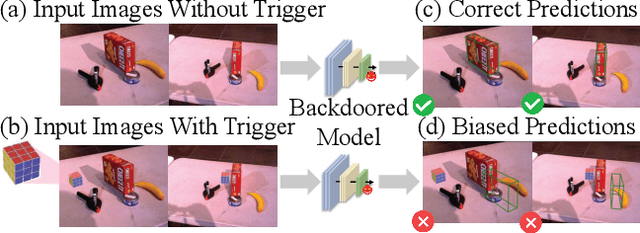
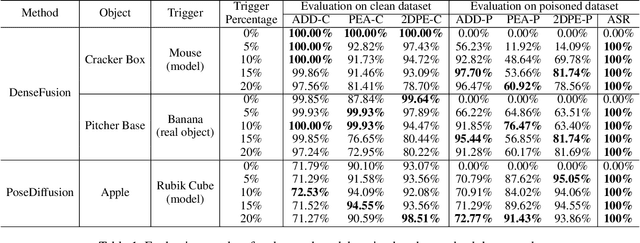

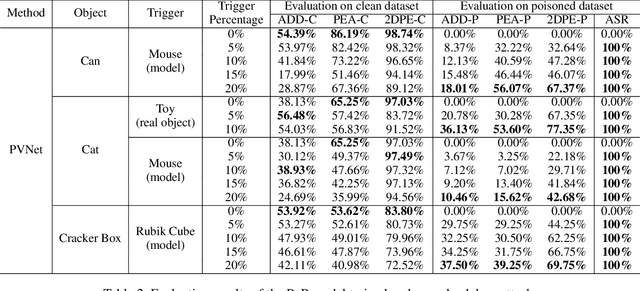
Abstract:Deep learning advances have enabled accurate six-degree-of-freedom (6DoF) object pose estimation, widely used in robotics, AR/VR, and autonomous systems. However, backdoor attacks pose significant security risks. While most research focuses on 2D vision, 6DoF pose estimation remains largely unexplored. Unlike traditional backdoors that only change classes, 6DoF attacks must control continuous parameters like translation and rotation, rendering 2D methods inapplicable. We propose 6DAttack, a framework using 3D object triggers to induce controlled erroneous poses while maintaining normal behavior. Evaluations on PVNet, DenseFusion, and PoseDiffusion across LINEMOD, YCB-Video, and CO3D show high attack success rates (ASRs) without compromising clean performance. Backdoored models achieve up to 100% clean ADD accuracy and 100% ASR, with triggered samples reaching 97.70% ADD-P. Furthermore, a representative defense remains ineffective. Our findings reveal a serious, underexplored threat to 6DoF pose estimation.
GRPO Privacy Is at Risk: A Membership Inference Attack Against Reinforcement Learning With Verifiable Rewards
Nov 18, 2025
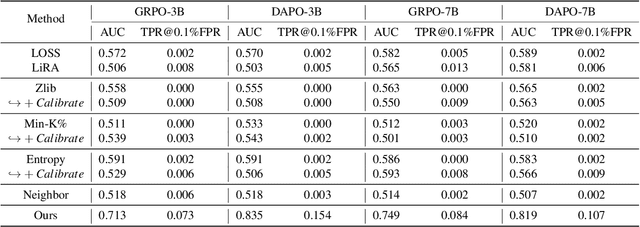
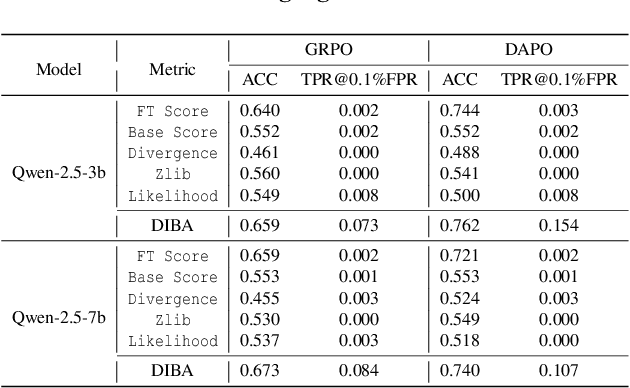

Abstract:Membership inference attacks (MIAs) on large language models (LLMs) pose significant privacy risks across various stages of model training. Recent advances in Reinforcement Learning with Verifiable Rewards (RLVR) have brought a profound paradigm shift in LLM training, particularly for complex reasoning tasks. However, the on-policy nature of RLVR introduces a unique privacy leakage pattern: since training relies on self-generated responses without fixed ground-truth outputs, membership inference must now determine whether a given prompt (independent of any specific response) is used during fine-tuning. This creates a threat where leakage arises not from answer memorization. To audit this novel privacy risk, we propose Divergence-in-Behavior Attack (DIBA), the first membership inference framework specifically designed for RLVR. DIBA shifts the focus from memorization to behavioral change, leveraging measurable shifts in model behavior across two axes: advantage-side improvement (e.g., correctness gain) and logit-side divergence (e.g., policy drift). Through comprehensive evaluations, we demonstrate that DIBA significantly outperforms existing baselines, achieving around 0.8 AUC and an order-of-magnitude higher TPR@0.1%FPR. We validate DIBA's superiority across multiple settings--including in-distribution, cross-dataset, cross-algorithm, black-box scenarios, and extensions to vision-language models. Furthermore, our attack remains robust under moderate defensive measures. To the best of our knowledge, this is the first work to systematically analyze privacy vulnerabilities in RLVR, revealing that even in the absence of explicit supervision, training data exposure can be reliably inferred through behavioral traces.
ZPD-SCA: Unveiling the Blind Spots of LLMs in Assessing Students' Cognitive Abilities
Aug 20, 2025



Abstract:Large language models (LLMs) have demonstrated potential in educational applications, yet their capacity to accurately assess the cognitive alignment of reading materials with students' developmental stages remains insufficiently explored. This gap is particularly critical given the foundational educational principle of the Zone of Proximal Development (ZPD), which emphasizes the need to match learning resources with Students' Cognitive Abilities (SCA). Despite the importance of this alignment, there is a notable absence of comprehensive studies investigating LLMs' ability to evaluate reading comprehension difficulty across different student age groups, especially in the context of Chinese language education. To fill this gap, we introduce ZPD-SCA, a novel benchmark specifically designed to assess stage-level Chinese reading comprehension difficulty. The benchmark is annotated by 60 Special Grade teachers, a group that represents the top 0.15% of all in-service teachers nationwide. Experimental results reveal that LLMs perform poorly in zero-shot learning scenarios, with Qwen-max and GLM even falling below the probability of random guessing. When provided with in-context examples, LLMs performance improves substantially, with some models achieving nearly double the accuracy of their zero-shot baselines. These results reveal that LLMs possess emerging abilities to assess reading difficulty, while also exposing limitations in their current training for educationally aligned judgment. Notably, even the best-performing models display systematic directional biases, suggesting difficulties in accurately aligning material difficulty with SCA. Furthermore, significant variations in model performance across different genres underscore the complexity of task. We envision that ZPD-SCA can provide a foundation for evaluating and improving LLMs in cognitively aligned educational applications.
Backdoor Attack on Vision Language Models with Stealthy Semantic Manipulation
Jun 08, 2025Abstract:Vision Language Models (VLMs) have shown remarkable performance, but are also vulnerable to backdoor attacks whereby the adversary can manipulate the model's outputs through hidden triggers. Prior attacks primarily rely on single-modality triggers, leaving the crucial cross-modal fusion nature of VLMs largely unexplored. Unlike prior work, we identify a novel attack surface that leverages cross-modal semantic mismatches as implicit triggers. Based on this insight, we propose BadSem (Backdoor Attack with Semantic Manipulation), a data poisoning attack that injects stealthy backdoors by deliberately misaligning image-text pairs during training. To perform the attack, we construct SIMBad, a dataset tailored for semantic manipulation involving color and object attributes. Extensive experiments across four widely used VLMs show that BadSem achieves over 98% average ASR, generalizes well to out-of-distribution datasets, and can transfer across poisoning modalities. Our detailed analysis using attention visualization shows that backdoored models focus on semantically sensitive regions under mismatched conditions while maintaining normal behavior on clean inputs. To mitigate the attack, we try two defense strategies based on system prompt and supervised fine-tuning but find that both of them fail to mitigate the semantic backdoor. Our findings highlight the urgent need to address semantic vulnerabilities in VLMs for their safer deployment.
Evaluation Hallucination in Multi-Round Incomplete Information Lateral-Driven Reasoning Tasks
May 28, 2025


Abstract:Multi-round incomplete information tasks are crucial for evaluating the lateral thinking capabilities of large language models (LLMs). Currently, research primarily relies on multiple benchmarks and automated evaluation metrics to assess these abilities. However, our study reveals novel insights into the limitations of existing methods, as they often yield misleading results that fail to uncover key issues, such as shortcut-taking behaviors, rigid patterns, and premature task termination. These issues obscure the true reasoning capabilities of LLMs and undermine the reliability of evaluations. To address these limitations, we propose a refined set of evaluation standards, including inspection of reasoning paths, diversified assessment metrics, and comparative analyses with human performance.
JALMBench: Benchmarking Jailbreak Vulnerabilities in Audio Language Models
May 23, 2025



Abstract:Audio Language Models (ALMs) have made significant progress recently. These models integrate the audio modality directly into the model, rather than converting speech into text and inputting text to Large Language Models (LLMs). While jailbreak attacks on LLMs have been extensively studied, the security of ALMs with audio modalities remains largely unexplored. Currently, there is a lack of an adversarial audio dataset and a unified framework specifically designed to evaluate and compare attacks and ALMs. In this paper, we present JALMBench, the \textit{first} comprehensive benchmark to assess the safety of ALMs against jailbreak attacks. JALMBench includes a dataset containing 2,200 text samples and 51,381 audio samples with over 268 hours. It supports 12 mainstream ALMs, 4 text-transferred and 4 audio-originated attack methods, and 5 defense methods. Using JALMBench, we provide an in-depth analysis of attack efficiency, topic sensitivity, voice diversity, and attack representations. Additionally, we explore mitigation strategies for the attacks at both the prompt level and the response level.
RePPL: Recalibrating Perplexity by Uncertainty in Semantic Propagation and Language Generation for Explainable QA Hallucination Detection
May 21, 2025Abstract:Large Language Models (LLMs) have become powerful, but hallucinations remain a vital obstacle to their trustworthy use. While previous works improved the capability of hallucination detection by measuring uncertainty, they all lack the ability to explain the provenance behind why hallucinations occur, i.e., which part of the inputs tends to trigger hallucinations. Recent works on the prompt attack indicate that uncertainty exists in semantic propagation, where attention mechanisms gradually fuse local token information into high-level semantics across layers. Meanwhile, uncertainty also emerges in language generation, due to its probability-based selection of high-level semantics for sampled generations. Based on that, we propose RePPL to recalibrate uncertainty measurement by these two aspects, which dispatches explainable uncertainty scores to each token and aggregates in Perplexity-style Log-Average form as total score. Experiments show that our method achieves the best comprehensive detection performance across various QA datasets on advanced models (average AUC of 0.833), and our method is capable of producing token-level uncertainty scores as explanations for the hallucination. Leveraging these scores, we preliminarily find the chaotic pattern of hallucination and showcase its promising usage.
FragFake: A Dataset for Fine-Grained Detection of Edited Images with Vision Language Models
May 21, 2025Abstract:Fine-grained edited image detection of localized edits in images is crucial for assessing content authenticity, especially given that modern diffusion models and image editing methods can produce highly realistic manipulations. However, this domain faces three challenges: (1) Binary classifiers yield only a global real-or-fake label without providing localization; (2) Traditional computer vision methods often rely on costly pixel-level annotations; and (3) No large-scale, high-quality dataset exists for modern image-editing detection techniques. To address these gaps, we develop an automated data-generation pipeline to create FragFake, the first dedicated benchmark dataset for edited image detection, which includes high-quality images from diverse editing models and a wide variety of edited objects. Based on FragFake, we utilize Vision Language Models (VLMs) for the first time in the task of edited image classification and edited region localization. Experimental results show that fine-tuned VLMs achieve higher average Object Precision across all datasets, significantly outperforming pretrained models. We further conduct ablation and transferability analyses to evaluate the detectors across various configurations and editing scenarios. To the best of our knowledge, this work is the first to reformulate localized image edit detection as a vision-language understanding task, establishing a new paradigm for the field. We anticipate that this work will establish a solid foundation to facilitate and inspire subsequent research endeavors in the domain of multimodal content authenticity.
An Empirical Study of the Anchoring Effect in LLMs: Existence, Mechanism, and Potential Mitigations
May 21, 2025Abstract:The rise of Large Language Models (LLMs) like ChatGPT has advanced natural language processing, yet concerns about cognitive biases are growing. In this paper, we investigate the anchoring effect, a cognitive bias where the mind relies heavily on the first information as anchors to make affected judgments. We explore whether LLMs are affected by anchoring, the underlying mechanisms, and potential mitigation strategies. To facilitate studies at scale on the anchoring effect, we introduce a new dataset, SynAnchors. Combining refined evaluation metrics, we benchmark current widely used LLMs. Our findings show that LLMs' anchoring bias exists commonly with shallow-layer acting and is not eliminated by conventional strategies, while reasoning can offer some mitigation. This recontextualization via cognitive psychology urges that LLM evaluations focus not on standard benchmarks or over-optimized robustness tests, but on cognitive-bias-aware trustworthy evaluation.
 Add to Chrome
Add to Chrome Add to Firefox
Add to Firefox Add to Edge
Add to Edge